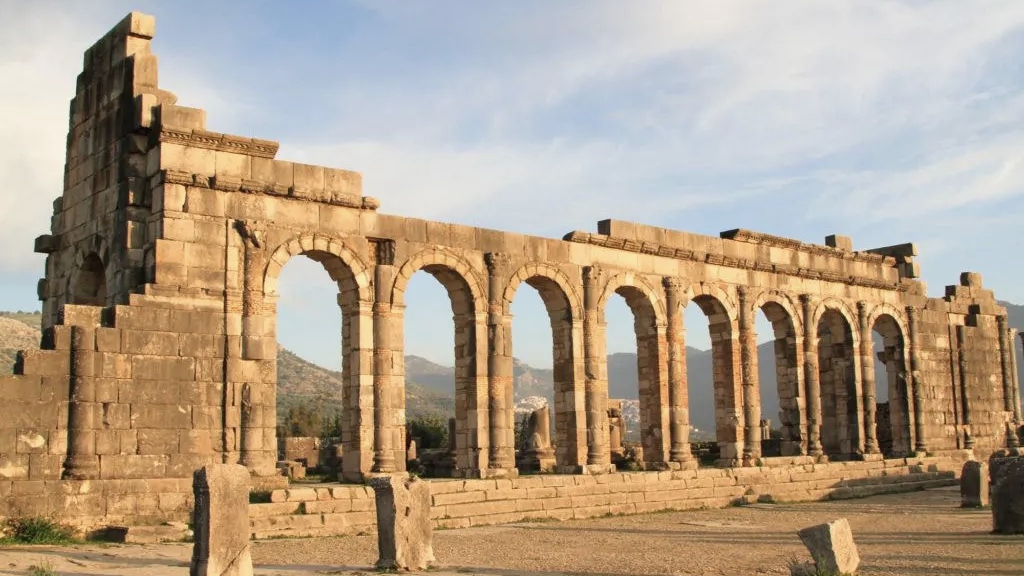
List of UNESCO World Heritage Sites in Morocco
The United Nations Educational, Scientific and Cultural Organization (UNESCO) World Heritage Sites are places of importance to cultural or natural heritage as described in the UNESCO World Heritage Convention, established in 1972. Cultural heritage consists of monuments (such as architectural works, monumental sculptures, or inscriptions), groups of buildings, and sites (including archaeological sites). Natural features (consisting of physical and biological formations), geological and physiographical formations (including habitats of threatened species of animals and plants), and natural sites which are important from the point of view of science, conservation, or natural beauty, are defined as natural heritage. The Kingdom of Morocco accepted the convention on 28 October 1975, making its historical sites eligible for inclusion on the list. There are nine World Heritage Sites in Morocco, all selected for their cultural significance.
Morocco’s first site, Medina of Fez, was inscribed on the list at the 5th Session of the World Heritage Committee, held in Paris, France in 1981. The most recent inscription, Rabat, Modern Capital and Historic City: a Shared Heritage, was added to the list in 2012. In addition, Morocco maintains a further 13 properties on the tentative list. Morocco has served on the World Heritage Committee twice.
| Site | Location (region) | Year listed | Description |
|---|---|---|---|
| Medina of Fez | Fès-Meknès | 1981 | Fez was founded in the 9th century, reached its apogee as the capital of the Marinid Sultanate in the 13th and 14th centuries, and remained the capital of the country until 1912. The medina is one of the most extensive and best-preserved old towns in the Muslim world. The main monuments date to the medieval period and include mosques, madrasas, palaces, and fountains. |
| Medina of Marrakesh | Marrakesh–Safi | 1985 | Marrakesh was founded in the 1070s as the capital of the Almoravid dynasty. It later became the capital of the Almohad dynasty, until the 13th century when the capital was moved to Fez. There are numerous monuments in the city including the Koutoubia Mosque (pictured), Jemaa el-Fnaa square, El Badi Palace, Bahia Palace, Saadian Tombs, several mosques, and madrasas. The medina remains a living town, preserving its traditional architecture, crafts, and trades.[8] |
| Ksar of Ait-Ben-Haddou | Drâa-Tafilalet | 1987 | Ait-Ben-Haddou is a ksar, a fortified village, a representative example of a settlement in southern Morocco. It was located on a trans-Saharan trade route. Earthen buildings are packed close together and defensive walls are fortified by towers at the corners. Some of the houses are decorated with motifs in clay brick. The earliest buildings of Ait-Ben-Haddou date from the 17th century although the construction techniques were already present in earlier periods in the region. |
| Historic City of Meknes | Fès-Meknès | 1996 | Meknes was founded in the 11th century by the Almoravids. In the 17th century, Sultan Moulay Isma’il ibn Sharif of the Alawi dynasty made it his capital and commissioned substantial construction projects, including monumental defensive walls and ramparts and the Kasbah of Moulay Ismail. The city layout incorporates both Islamic and European aspects of architecture and town planning. Bab Mansur al-‘Alj is pictured. |
| Archaeological site of Volubilis | Fès-Meknès | 1997 | Volubilis was founded in the 3rd century BCE as the capital of Mauretania. It was then an important Roman outpost and in the 8th century briefly the capital of the Idrisid dynasty. Afterwards, the site was not occupied for nearly a thousand years. This resulted in remains having been well preserved, making Volubilis one of the richest sites for archeology in North Africa. The remains demonstrate the interactions of different cultures of the Mediterranean through centuries. A mosaic from the Roman period is pictured. A minor boundary modification took place in 2008. |
| Medina of Tétouan (formerly known as Titawin) | Tanger-Tetouan-Al Hoceima | 1997 | Located just south of the Strait of Gibraltar, Tétouan served as the connection point between Morocco and Andalusia from the 8th century onward. Following the Reconquista, it was rebuilt by refugees expelled by the Spanish, and the Andalusian influence is clearly visible in arts and architecture. In the following centuries, it served as the meeting point between the Spanish and Arab civilizations. The medina quarter is among the smallest in Morocco but it is well preserved. |
| Medina of Essaouira (formerly Mogador) | Marrakesh-Safi | 2001 | Essaouira was founded by the Alawi Sultan Mohammed ben Abdallah in the second half of the 18th century, with the aim of establishing a major port and trading centre. The city was designed by French architects who followed the principles of French military engineer Marquis of Vauban. In the late 18th and 19th centuries, Essaouira was one of the major Atlantic trading centres between Africa and Europe. Today, the city mainly preserves its European appearance. |
| Portuguese City of Mazagan (El Jadida) | Casablanca-Settat | 2004 | In the early 16th century, the Portuguese built the fortified colony of Mazagão as one of the stops on the route to India. They kept it until 1769. The city fortifications followed the principles of Renaissance military engineering, with a star fort plan. Inside the walls, several historic buildings have been preserved, including the Manueline Church of the Assumption and the cistern. |
| Rabat, Modern Capital and Historic City: a Shared Heritage | Rabat-Salé-Kénitra | 2012 | Rabat was rebuilt as the capital of the French protectorate from 1912 to the 1930s. The city is a good example of early 20th century urban planning and is one of the biggest and most ambitious urban projects of the period in Africa. The modern city integrates the buildings from the earlier periods, including the 12th century Kasbah of the Udayas (walls pictured), Hassan Tower, and the Almohad walls and ramparts. |
